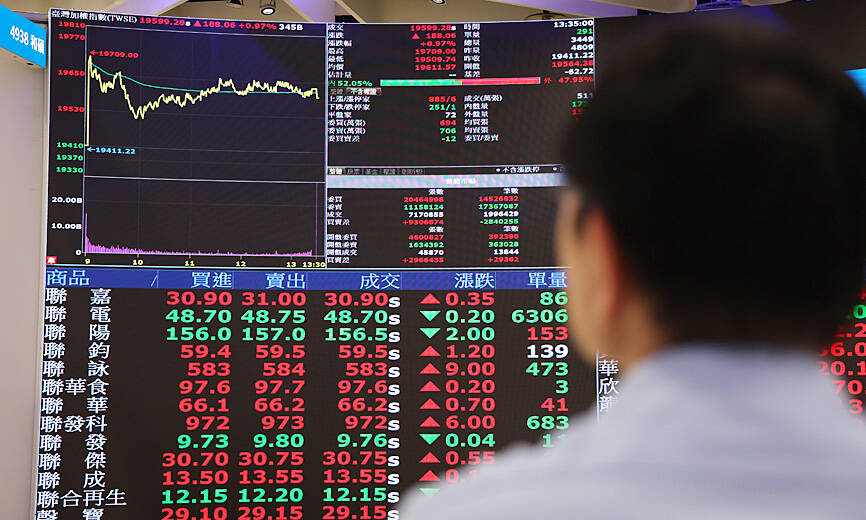The nation’s securities account balance, a gauge of retail investors’ confidence in local equities, rose to its highest level last month, as the TAIEX rallied 1,327.68 points — or 7 percent — in the month, data released by the central bank showed yesterday.
The securities account balance increased for a second consecutive month to NT$3.51 trillion (US$107.9 billion), up NT$56.4 billion from NT$3.45 trillion the previous month, the data showed.
The continued increase in the securities account balance came as the TAIEX mostly held above 20,000 points last month on the back of steady support from retail investors and domestic institutional investors, although foreign institutional investors only bought a net NT$22.7 billion of local shares, compared with a net buy of NT$116.2 billion the previous month, Taiwan Stock Exchange (TWSE) data showed.

Photo: CNA
Last month, retail investors accounted for 55.42 percent of the main board's trading volume, compared with 55.39 percent one month earlier, and local institutional investors made up 12.46 percent of the total trade, up from 11.58 percent the previous month, TWSE data showed.
In comparison, foreign institutional players’ proportion of market transactions fell to 32.12 percent, from 33.03 percent, the data showed.
The central bank’s latest data reflected that stock market sentiment remained bullish in the first quarter of the year as the TAIEX averaged 19,843 points last month, up from 18,612 points in February and 17,668 points in January.
The balance of margin loans increased to NT$379 billion last month, up from NT$351.3 billion the previous month and NT$334.7 billion in January, hitting a 13-year high, it said.
Meanwhile, the daily average turnover on the main board also expanded to NT$441.2 billion, compared with NT$363.9 billion in February and NT$280.8 billion in January, it added.
The TAIEX yesterday closed at 20,131.74 points, up 2.72 percent from the previous session, having risen 9.31 percent so far this year, with a turnover of NT$427.562 billion, TWSE data showed.
The securities account balance this month might decrease as the TAIEX underwent a consolidation in line with the recent volatility in US equities, the central bank said.
The bank attributed the cautious market sentiment to factors such as investors’ growing reservations about the US Federal Reserve’s first rate cut, Taiwan Semiconductor Manufacturing Co’s (台積電) downbeat forecast for the global semiconductor industry this year, and more industry watchers turning wary about the outlook for major players in the artificial intelligence and electric vehicle fields.
However, Taiwan still has abundant funds and the liquidity momentum in capital markets remains strong, which is conducive to the stock market and the economy as a whole, the bank said.
With the continued increase in the securities account balance, M1B money supply — a measure of money in circulation, including currency and passbook savings deposits — posted an annual growth rate of 5.38 percent last month, up from a 4.47 percent increase in February, the central bank said.
The annual growth rate in the broader measure M2 — which includes time deposits, time-saving deposits, foreign currency deposits, mutual funds and M1B — rose to 6.15 percent from 5.59 percent, the bank said, attributing the increase to net foreign capital inflows.
In the first three months of the year, M1B rose 4.47 percent and M2 advanced 5.73 percent from a year earlier, which is still within the central bank’s target of 2.5 percent to 6.5 percent in annual growth, it said.

The New Taiwan dollar is on the verge of overtaking the yuan as Asia’s best carry-trade target given its lower risk of interest-rate and currency volatility. A strategy of borrowing the New Taiwan dollar to invest in higher-yielding alternatives has generated the second-highest return over the past month among Asian currencies behind the yuan, based on the Sharpe ratio that measures risk-adjusted relative returns. The New Taiwan dollar may soon replace its Chinese peer as the region’s favored carry trade tool, analysts say, citing Beijing’s efforts to support the yuan that can create wild swings in borrowing costs. In contrast,

Nvidia Corp’s demand for advanced packaging from Taiwan Semiconductor Manufacturing Co (TSMC, 台積電) remains strong though the kind of technology it needs is changing, Nvidia CEO Jensen Huang (黃仁勳) said yesterday, after he was asked whether the company was cutting orders. Nvidia’s most advanced artificial intelligence (AI) chip, Blackwell, consists of multiple chips glued together using a complex chip-on-wafer-on-substrate (CoWoS) advanced packaging technology offered by TSMC, Nvidia’s main contract chipmaker. “As we move into Blackwell, we will use largely CoWoS-L. Of course, we’re still manufacturing Hopper, and Hopper will use CowoS-S. We will also transition the CoWoS-S capacity to CoWos-L,” Huang said

Nvidia Corp CEO Jensen Huang (黃仁勳) is expected to miss the inauguration of US president-elect Donald Trump on Monday, bucking a trend among high-profile US technology leaders. Huang is visiting East Asia this week, as he typically does around the time of the Lunar New Year, a person familiar with the situation said. He has never previously attended a US presidential inauguration, said the person, who asked not to be identified, because the plans have not been announced. That makes Nvidia an exception among the most valuable technology companies, most of which are sending cofounders or CEOs to the event. That includes

INDUSTRY LEADER: TSMC aims to continue outperforming the industry’s growth and makes 2025 another strong growth year, chairman and CEO C.C. Wei says Taiwan Semiconductor Manufacturing Co (TSMC, 台積電), a major chip supplier to Nvidia Corp and Apple Inc, yesterday said it aims to grow revenue by about 25 percent this year, driven by robust demand for artificial intelligence (AI) chips. That means TSMC would continue to outpace the foundry industry’s 10 percent annual growth this year based on the chipmaker’s estimate. The chipmaker expects revenue from AI-related chips to double this year, extending a three-fold increase last year. The growth would quicken over the next five years at a compound annual growth rate of 45 percent, fueled by strong demand for the high-performance computing